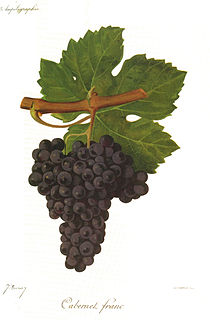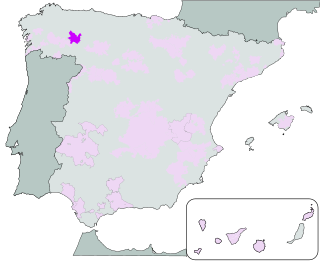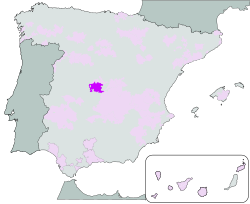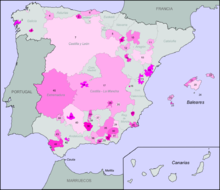
Cabernet Franc is one of the major black grape varieties worldwide. It is principally grown for blending with Cabernet Sauvignon and Merlot in the Bordeaux style, but can also be vinified alone, as in the Loire's Chinon. In addition to being used in blends and produced as a varietal in Canada and the United States, it is sometimes made into ice wine in those regions.

Chilean wine has a long history for a New World wine region, as it was the 16th century when the Spanish conquistadors brought Vitis vinifera vines with them as they colonized the region. In the mid-19th century, French wine varieties such as Cabernet Sauvignon, Merlot, Carmenère and Franc were introduced. In the early 1980s, a renaissance began with the introduction of stainless steel fermentation tanks and the use of oak barrels for aging. Wine exports grew very quickly as quality wine production increased. The number of wineries has grown from 12 in 1995 to over 70 in 2005.

Binissalem is a small municipality in the district of Raiguer on Majorca, one of the Balearic Islands, Spain.

Bierzo is a Spanish Denominación de Origen (DO) for wines located in the northwest of the province of León and covers about 3,000 km². It borders on the provinces of Ourense, Lugo and Asturias in the north and in the south on areas of La Montaña, la Cabrera and La Meseta, in Léon. The area consists of numerous small valleys in the mountainous part and of a wide, flat plain . The DO covers 23 municipalities including the largest town of the area, Ponferrada.

Campo de Borja is a Spanish Denominación de Origen (DO) for wines located in the Campo de Borja comarca, northwest of the province of Zaragoza. It is a transition zone between the plains of the River Ebro and the mountains of the Sistema Ibérico. The DO comprises 16 municipalities. These are Ainzón, Agón, Albeta, Ambel, Bisimbre, Borja, Bulbuente, Bureta, Fréscano, Fuendejalón, Magallón, Maleján, Mallén, Pozuelo de Aragón, Tabuenca and Vera de Moncayo. The Moncayo mountain is the dominant feature of the DO and creates a microclimate which gives the wines a special character.

La Mancha is a Spanish Denominación de Origen (DO) for wines, with over 190,000 ha planted to vines, and is the largest continuous vine-growing area in the world. It is located in the autonomous community of Castile-La Mancha in central Spain and includes 182 municipalities: 12 in the province of Albacete, 58 in Ciudad Real, 66 in Cuenca and 46 in Toledo. 22,000 grape-growers and over 300 wineries (bodegas) are registered with the DO, which was formally created in 1976.

Mondéjar is a Spanish Denominación de Origen (DO) for wines located in the southeast corner of the province of Guadalajara, around the town of Mondéjar. It covers 19 municipalities, the most important one being Sacedón.

Valdepeñas is a Spanish Denominación de Origen (DO) for wines located in the province of Ciudad Real in the south of Castile-La Mancha (Spain). It is almost completely surrounded by another DO but is an independent DO due to its long history of producing a distinct style of wine known aloque or clarete which is made by mixing white and red grapes. 2016´s harvest is formed by 55.9 million kilos of red grapes and 43.2 million kilos of white grapes.

Jumilla is a Spanish Denominación de Origen (DO) for wines that extends over the north of the region of Murcia, Spain. The area includes the municipality of Jumilla, from which it takes its name, and the contiguous southeast of the Albacete province in the Castile-La Mancha region.

Alella is a Spanish Denominación de Origen (DO) for wines produced in Maresme county in the province of Barcelona in the Spanish autonomous communities of Catalonia, located on the Mediterranean coast, 15 km to the north of the city of Barcelona.

Rueda is a Spanish Denominación de Origen (DO) for wines located in the Community of Castile and León. It comprises 72 municipalities, of which 53 are in the province of Valladolid, 17 are in the north of the province of Segovia, and 2 are in the north of the province of Ávila. It is known primarily for its fine white wines based on the verdejo grape.

Conca de Barberà is a Spanish Denominación de Origen (DO) for wines located in central Catalonia in the north of the province of Tarragona in the valleys of the rivers Francolí and Anguera, and is known for its white wines.

Costers del Segre is a Spanish Denominación de Origen (DO) for wines located in the province of Lleida and is divided into several separate sub-zones. The four original subzones created in 1988 are Artesa, to the northeast of Lleida, Valls de Riucorb to the east, Garrigues and Raïmat. In 1998 two other subzones were added: Pallars Jussà, next to the town of Tremp, 90 km north of Lleida and Segrià to the west and surrounded by the Raimat subzone.

Pla de Bages is a Spanish Denominación de Origen (DO) for wines, located in the province of Barcelona, and is one of the smallest DOs in Spain, covering only 600 hectares. It is also one of the newest having acquired its official status in 1995.

Priorat is a Catalan Denominació d'Origen Qualificada (DOQ) for wines produced in the Priorat county, in the province of Tarragona, in the southwest of Catalonia.

Terra Alta is a Catalan Denominación de Origen (DO) for wines located in the west of the province of Tarragona and covers 12 inland municipalities. As the name indicates the area is in the mountains. It features in a number of Picasso’s paintings.
Guijoso is a Vino de Pago from Spain. This is the highest category on the quality scale of Spanish wines and means that in addition to having a proven track record of consistent quality, the wines have to be both produced from estate-grown grapes and also have to be processed and aged in a winery (bodega) located on the estate.

Navarra is a Spanish Denominación de Origen (DO) for wines that extends over practically the entire southern half of the autonomous community of Navarre. The vineyards are on the lower slopes of the Pyrenees as they descend towards the basin of the river Ebro.

Binissalem-Mallorca is a Spanish Denominación de Origen (DO) for wines located around the town of Binissalem in the centre of the island of Majorca,.

Uclés is a Spanish Denominación de Origen (DO) for wines located in the region of Castile-La Mancha, (Spain), around the town of Uclés in the west of the province of Cuenca and in the northeast of the province of Toledo.




























